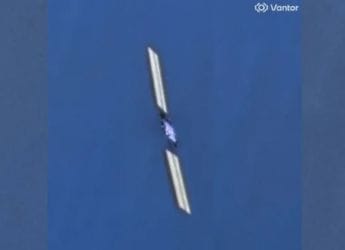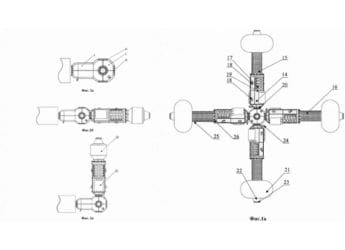- Home
- Science
- Science News
- Astronomers Discover Closest Known Molecular Cloud to Earth
Astronomers Discover Closest Known Molecular Cloud to Earth
Eos, a newly discovered hydrogen cloud just 300 light-years from Earth, offers a rare look at hidden star-forming regions. Found via hydrogen fluorescence rather than carbon monoxide, Eos may reshape how astronomers detect and study molecular clouds in our galaxy.

Photo Credit: Thomas Müller (HdA/MPIA) and Thavisha Dharmawardena (NYU)
Eos, a molecular cloud, ranks among the largest individual structures visible in Earth’s sky
Astronomers found the nearest known molecular cloud to Earth, providing scientists with a unique up-close look at the cosmic recycling of matter that drives the formation of new planets and stars.
The newly discovered cloud, named "Eos" after the Greek goddess of dawn, is a massive, crescent-shaped mass of hydrogen gas that is only 300 light-years away from Earth. It is one of the biggest formations in the sky, spanning the equivalent of around 40 Earth moons arranged side by side at a width of nearly 100 light-years.
How it escaped detection
According to a paper published April 28 in the journal Nature Astronomy, Eos has so far escaped detection because of its low concentration of carbon monoxide (CO), a bright, easily detectable chemical signature that astronomers typically use to identify molecular clouds, despite its massive size and relative proximity to Earth. The researchers detected Eos through the fluorescent glow of hydrogen molecules within it — a novel approach that could reveal many similarly hidden clouds throughout the galaxy. Burkhart said to Live Sciences, "There definitely are more CO-dark clouds waiting to be discovered."
Formation of Eos and further studies
Eos has been shaped into its crescent shape through interactions with the North Polar Spur, a vast region of ionized gas. The shape aligns perfectly with the North Polar Spur at high latitudes, suggesting that energy and radiation from this massive structure have influenced the surrounding gas, including Eos. It will evaporate in about 6 million years due to its molecular hydrogen reservoir being torn apart by incoming photons and high-energy cosmic rays. A follow-up study found no significant bursts of star formation in the past, but it remains uncertain whether the cloud will begin to form stars before dissipating. A NASA spacecraft named after the newly discovered molecular cloud is being developed to observe in far-ultraviolet wavelengths to measure the molecular hydrogen content in clouds across the Milky Way.
Get your daily dose of tech news, reviews, and insights, in under 80 characters on Gadgets 360 Turbo. Connect with fellow tech lovers on our Forum. Follow us on X, Facebook, WhatsApp, Threads and Google News for instant updates. Catch all the action on our YouTube channel.
- Samsung Galaxy Unpacked 2025
- ChatGPT
- Redmi Note 14 Pro+
- iPhone 16
- Apple Vision Pro
- Oneplus 12
- OnePlus Nord CE 3 Lite 5G
- iPhone 13
- Xiaomi 14 Pro
- Oppo Find N3
- Tecno Spark Go (2023)
- Realme V30
- Best Phones Under 25000
- Samsung Galaxy S24 Series
- Cryptocurrency
- iQoo 12
- Samsung Galaxy S24 Ultra
- Giottus
- Samsung Galaxy Z Flip 5
- Apple 'Scary Fast'
- Housefull 5
- GoPro Hero 12 Black Review
- Invincible Season 2
- JioGlass
- HD Ready TV
- Laptop Under 50000
- Smartwatch Under 10000
- Latest Mobile Phones
- Compare Phones
- Huawei Nova 15
- Huawei Nova 15 Pro
- Huawei Nova 15 Ultra
- OnePlus 15R
- Realme Narzo 90x 5G
- Realme Narzo 90 5G
- Vivo S50 Pro Mini
- Vivo S50
- Asus ProArt P16
- MacBook Pro 14-inch (M5, 2025)
- Huawei MatePad 11.5 (2026)
- OnePlus Pad Go 2 (5G)
- Huawei Watch 10th Anniversary Edition
- OnePlus Watch Lite
- Acerpure Nitro Z Series 100-inch QLED TV
- Samsung 43 Inch LED Ultra HD (4K) Smart TV (UA43UE81AFULXL)
- Asus ROG Ally
- Nintendo Switch Lite
- Haier 1.6 Ton 5 Star Inverter Split AC (HSU19G-MZAID5BN-INV)
- Haier 1.6 Ton 5 Star Inverter Split AC (HSU19G-MZAIM5BN-INV)












